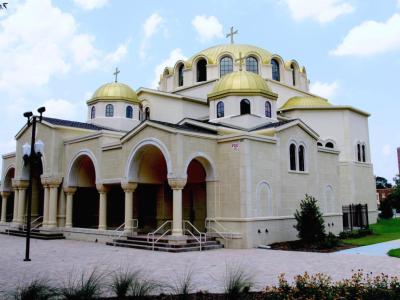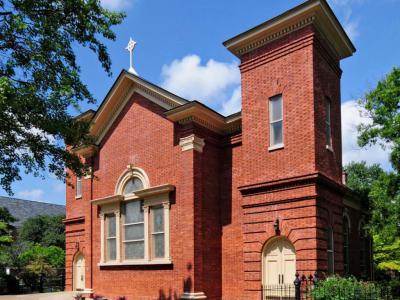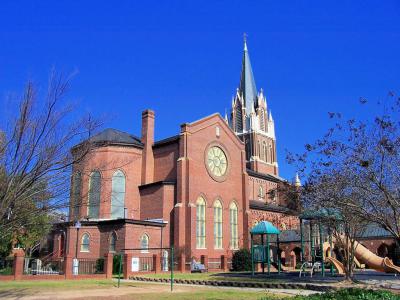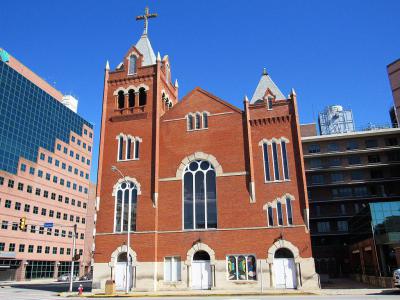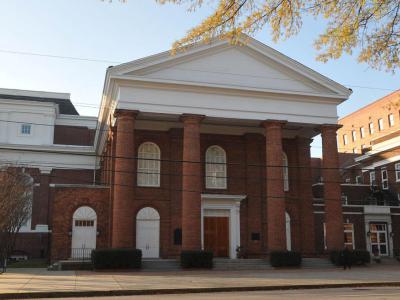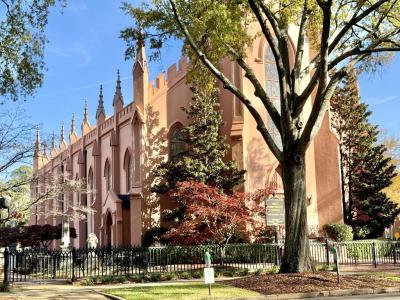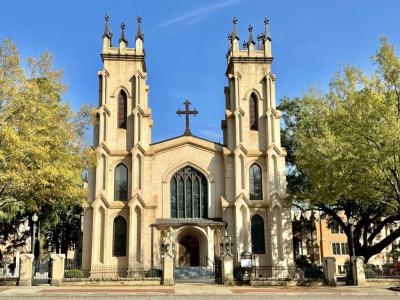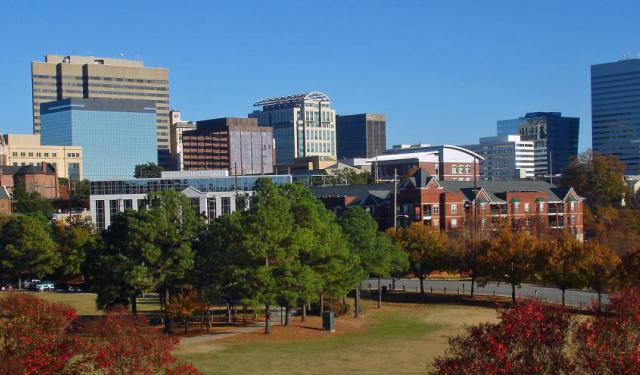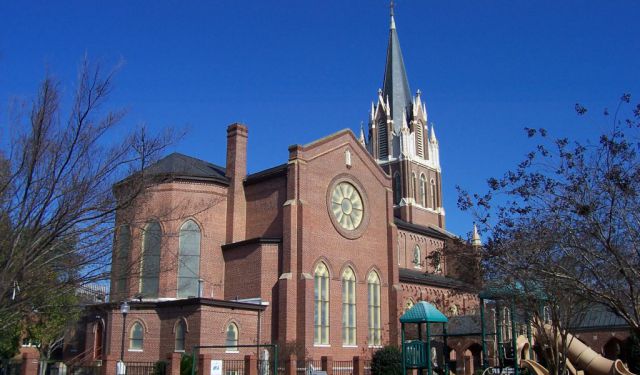
Historical Churches Walking Tour (Self Guided), Columbia
Columbia has a variety of religious buildings, new and old that have an important cultural, historical and religious value in the entire South Carolina district. Most of them were renovated due to wars and natural causes but almost all of them tried to preserve the initial style elements that make them unique and attractive to tourists. This tour will guide you to some of the most famous churches in Columbia.
How it works: Download the app "GPSmyCity: Walks in 1K+ Cities" from Apple App Store or Google Play Store to your mobile phone or tablet. The app turns your mobile device into a personal tour guide and its built-in GPS navigation functions guide you from one tour stop to next. The app works offline, so no data plan is needed when traveling abroad.
Historical Churches Walking Tour Map
Guide Name: Historical Churches Walking Tour
Guide Location: USA » Columbia (See other walking tours in Columbia)
Guide Type: Self-guided Walking Tour (Sightseeing)
# of Attractions: 7
Tour Duration: 1 Hour(s)
Travel Distance: 2.4 Km or 1.5 Miles
Author: jenny
Sight(s) Featured in This Guide:
Guide Location: USA » Columbia (See other walking tours in Columbia)
Guide Type: Self-guided Walking Tour (Sightseeing)
# of Attractions: 7
Tour Duration: 1 Hour(s)
Travel Distance: 2.4 Km or 1.5 Miles
Author: jenny
Sight(s) Featured in This Guide:
- Holy Trinity Greek Orthodox Church
- Ebenezer Lutheran Church
- St. Peter's Catholic Church
- Bethel A.M.E. Church
- First Baptist Church
- First Presbyterian Church
- Trinity Episcopal Cathedral
1) Holy Trinity Greek Orthodox Church (must see)
Holly Trinity Greek Orthodox Church represents a spiritual home for those families from Columbia and all of South Carolina who believe in God and who consider the influence of the Greek church important. The church was established in 1936 and keeps services and traditions until today. The most recent news is that this church is building a new sanctuary that will have a Byzantine architectural style, more modern and more comfortable for people because of air conditioning, arches and electric conduits. The interiors are made of stone and will soon be open to the public.
2) Ebenezer Lutheran Church
Ebenezer Lutheran Church is a spacious and beautiful church that was built in 1931, designed by architect James B. Urquhart in Neo-Gothic Style, with a nice bit of Art-deco features. The Lutheran congregation appeared in Columbia in 1831. In 1993 the building of the church was dedicated to this Ebenezer church. Because this religious movement was very important, the location, the pastors, the staff and all things related to this church were taken care of right away. Now it is a place where people come to pray and even to celebrate some important religious holidays where a beautiful choir attracts your attention through their repertoire and beautiful interpretation.
3) St. Peter's Catholic Church
St. Peter's Roman Catholic Church is located at 1529 Assembly St. in Columbia. This is the second building of the oldest Catholic parish in Columbia and the Midlands of South Carolina. The first resident Catholic priest came to Columbia in 1820. St. Peter's first church, designed by the South Carolina architect Robert Mills, was completed in 1824. This church was demolished in the early 1900s to build the new sanctuary.
The new church was designed by Frank Pierce Milburn, a Southern architect. Construction started in 1906 and was completed in 1908. The Gothic Revival church was built with dark red brick with Bedford limestone and dull glazed terra cotta trim. The roof was Buckingham Slate. The spire is topped with a cross and is 163 ft above grade. The church has a cruciform plan with a high nave. It is 131 ft long and 79 ft wide. The nave is 64 ft long and 51 ft tall. The 3,500 lb, 55 inches diameter bell was cast in 1911 by McShane Bell Foundry in Baltimore, Maryland.
The new church was designed by Frank Pierce Milburn, a Southern architect. Construction started in 1906 and was completed in 1908. The Gothic Revival church was built with dark red brick with Bedford limestone and dull glazed terra cotta trim. The roof was Buckingham Slate. The spire is topped with a cross and is 163 ft above grade. The church has a cruciform plan with a high nave. It is 131 ft long and 79 ft wide. The nave is 64 ft long and 51 ft tall. The 3,500 lb, 55 inches diameter bell was cast in 1911 by McShane Bell Foundry in Baltimore, Maryland.
Sight description based on Wikipedia.
4) Bethel A.M.E. Church
Bethel A.M.E. Church is a historical church that was built in 1921 and was included in the National Register in 1982. It has a Romanesque architectural style built by the African American architect John Anderson Lankford, one of the first registered African American architects. The church has a rectangular form with two towers in front of the building. The first tower is three stages above the basement and the second tower two stages above the basement. The facade center has a three-arched stained window. There are no services held any more but it has another mission, that of becoming a religious center for all the people that believe in God.
5) First Baptist Church
The First Baptist Church in Columbia is a Greek Revival building built in 1856. A convention met here on December 17, 1860 which voted unanimously for South Carolina to secede from the United States, leading to the American Civil War. It was first organized in 1809, with the building of the first church building, located on Sumter Street, in 1811. The second and current First Baptist Church was built in 1856 by an unknown architect. Its construction was funded by James P. Boyce, a former president of the Southern Baptist Theological Seminary.
The following year, in 1860, the Church was the site of the first state convention to discuss secession following the election of Abraham Lincoln as President of the United States. It was chosen because it was the largest meeting place in Columbia. Under the chairmanship of D. F. Jamison, a unanimous vote of 159-0 in favor of secession on December 17, 1860 led to South Carolina seceding from the United States Six other states would follow South Carolina's lead before the Battle of Fort Sumter; some felt if they did not secede now, they might lose the argument that a state had the right to secede, a right that has never been confirmed or denied by a court of law.
The following year, in 1860, the Church was the site of the first state convention to discuss secession following the election of Abraham Lincoln as President of the United States. It was chosen because it was the largest meeting place in Columbia. Under the chairmanship of D. F. Jamison, a unanimous vote of 159-0 in favor of secession on December 17, 1860 led to South Carolina seceding from the United States Six other states would follow South Carolina's lead before the Battle of Fort Sumter; some felt if they did not secede now, they might lose the argument that a state had the right to secede, a right that has never been confirmed or denied by a court of law.
Sight description based on Wikipedia.
6) First Presbyterian Church
The First Presbyterian Church is a historic church building in Columbia. Although the first meetings of what would become the First Presbyterian Church were held in 1795, the congregation did not have a building of its own until 1813. In 1813, the South Carolina Legislature incorporated the church as the "First Presbyterian Church of the Town of Columbia".
The current site of the church was a shared cemetery with the local Episcopal congregation from 1794 to 1813. The legislature gave the cemetery and other lands to be shared between the Episcopalians and the Presbyterians. A local legend says that First Presbyterian and the now-nearby Trinity Episcopal Cathedral drew lots to determine which congregation would get what lot, with First Presbyterian receiving the cemetery, located at the corner of Lady and Marion Streets.
The 1813 building still exists, and is now known as Jackson Hall. A new, larger English Gothic structure was built in 1854. Though spared the torch during Sherman's march to the sea, the building's original 180-foot spire was destroyed in an 1875 hurricane, and rebuilt in 1888. The spire was again damaged in a 1910 fire, and rebuilt to be eight feet taller. A remodeling in 1925 increased the capacity of the building to 1,250 from 800, increasing the length of the building by 40 feet. At the same time, classrooms were built at the sides, a choir loft added in the rear, and the organ loft rebuilt.
The current site of the church was a shared cemetery with the local Episcopal congregation from 1794 to 1813. The legislature gave the cemetery and other lands to be shared between the Episcopalians and the Presbyterians. A local legend says that First Presbyterian and the now-nearby Trinity Episcopal Cathedral drew lots to determine which congregation would get what lot, with First Presbyterian receiving the cemetery, located at the corner of Lady and Marion Streets.
The 1813 building still exists, and is now known as Jackson Hall. A new, larger English Gothic structure was built in 1854. Though spared the torch during Sherman's march to the sea, the building's original 180-foot spire was destroyed in an 1875 hurricane, and rebuilt in 1888. The spire was again damaged in a 1910 fire, and rebuilt to be eight feet taller. A remodeling in 1925 increased the capacity of the building to 1,250 from 800, increasing the length of the building by 40 feet. At the same time, classrooms were built at the sides, a choir loft added in the rear, and the organ loft rebuilt.
Sight description based on Wikipedia.
7) Trinity Episcopal Cathedral (must see)
Trinity Episcopal Church, now known as Trinity Episcopal Cathedral, is the first Episcopal and the oldest surviving sanctuary in Columbia. It is a Gothic Revival church that is modeled after York Minster in York, England. It was named to the National Register of Historic Places on February 24, 1971. Trinity Church is on east side of Sumter Street between Gervais and Senate Streets. It is directly east of the South Carolina State House.
The Gothic Revival church was designed by Edward Brickell White to resemble medieval York Minster. The cornerstone was laid on November 26, 1845, by the rector, Peter Shand. Although the church had a cruciform design, only the nave and the twin towers were constructed. Each tower had eight pinnacles topped with a fleur de lis. The brick structure was plastered with buff stucco. The towers and walls have shouldered buttresses. The nave has a clerestory, which is the only one in a Columbia church. The roof is supported on exposed wooden beams. Bishop Gadsden consecrated the church on February 14, 1857.
At various times in the history of the Parish, three live oak trees were planted in the churchyard. The Sire Oak was planted in 1814 after the first church was built. The second was planted in 1900 after finishing the church. The third tree was planted in 1925 when the Parish House was finished. There is a wrought iron fence around the churchyard.
The Gothic Revival church was designed by Edward Brickell White to resemble medieval York Minster. The cornerstone was laid on November 26, 1845, by the rector, Peter Shand. Although the church had a cruciform design, only the nave and the twin towers were constructed. Each tower had eight pinnacles topped with a fleur de lis. The brick structure was plastered with buff stucco. The towers and walls have shouldered buttresses. The nave has a clerestory, which is the only one in a Columbia church. The roof is supported on exposed wooden beams. Bishop Gadsden consecrated the church on February 14, 1857.
At various times in the history of the Parish, three live oak trees were planted in the churchyard. The Sire Oak was planted in 1814 after the first church was built. The second was planted in 1900 after finishing the church. The third tree was planted in 1925 when the Parish House was finished. There is a wrought iron fence around the churchyard.
Sight description based on Wikipedia.
Walking Tours in Columbia, South Carolina
Create Your Own Walk in Columbia
Creating your own self-guided walk in Columbia is easy and fun. Choose the city attractions that you want to see and a walk route map will be created just for you. You can even set your hotel as the start point of the walk.
Columbia Introduction Walking Tour
Columbia is a beautiful city, the largest one in South Carolina, with a great history and beautiful landmarks. It has a large number of old houses that are now museums and that represent a whole part of the history. All these houses have been named after famous personalities and families from years ago. Take this tour and discover the beauty of downtown attractions.
Tour Duration: 3 Hour(s)
Travel Distance: 5.6 Km or 3.5 Miles
Tour Duration: 3 Hour(s)
Travel Distance: 5.6 Km or 3.5 Miles
The Most Popular Cities
/ view all
